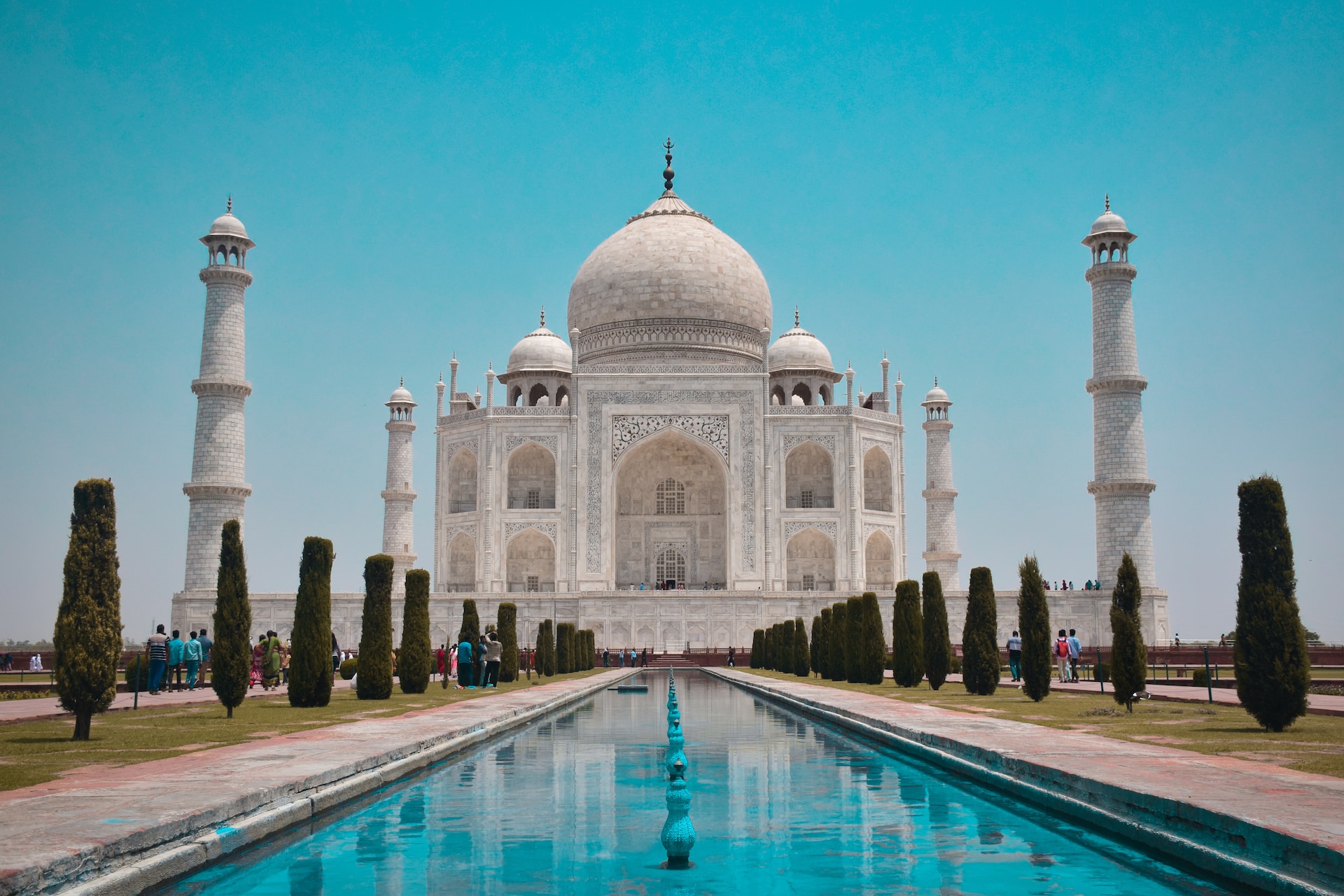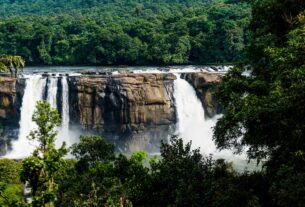The nation of “India,” which is well-known for its incredible architectural splendors, has always astounded visitors from all over the world. The fusion of vibrant history and variety with a dash of royal flair has consistently left a lasting impression on the audience. The structures, artifacts, and magnificent, well-rugged designs of monuments in India reveal the history of many historical events.
List of Top 7 Famous Monuments in India
Check out the popular historical monument in India.
1. Taj Mahal
Due to its intricately integrated white marble mausoleum, the Taj Mahal is considered one of India’s most famous structures. It was created in Agra, Uttar Pradesh, close to the banks of the Yamuna River, and the root is reachable. Let’s examine the history of its production before admiring its inherent beauty. The Taj Mahal is the pinnacle of unadulterated beauty among the many marble mausoleum built by the Mughal dynasty. The Taj Mahal is made up of tombs since it was built by Mughal Emperor Shah Jahan (1592-1666) in honor of his devoted wife Mumtaz Mahal (1593-1631).
Because renowned poet Shri Rabindranath Tagore called it a “teardrop on the cheek of eternity,” it is more than a mausoleum. the term used to honor genius in architecture! Fountains, excellent gardens, and the magnificent big decorative Gateway, on which quartic inscriptions are inscribed in calligraphic text type, are all features of the Taj Mahal.
The Taj Mahal is only 200 kilometers from Delhi, so one may travel there by plane, train, or road at their convenience. Additionally, the greatest time to go, explore, and take in the Taj Mahal’s natural splendor is from October to February during the autumn, winter, or spring.
2. Lotus Temple
The Lotus Temple is one of the top 7 famous monuments in India because of its design, which resembles a half-opened lotus flower. It is said to as India’s mother temple and draws visitors just due to its magnificent shape design. Every year, millions of tourists and believers from all over the world congregate to see the Lotus Temple in order to receive blessings from the gods and to take in the incredible environment and tranquility. The building’s style blends conventional and contemporary engineering, and there is a chamber designated for meditation. The inspiration and development of the design came from Fariborz Sahba. The plan’s development and implementation took around ten years, but the wait was worthwhile.
The Lotus Temple is quite easy to go to because a metro can take you there. You must take the Nehru Place–Kalkaji Mandir metro, and after 5 minutes of walking, you will arrive at your desired location. The Lotus Temple was established in 1986, and its summer hours of operation are 9:00 am to 7:00 pm. The closure time changes to 5:30 pm in the winter.
3. Qutub Minar
The 14.32-meter-tall Qutub Minar is a symbolic imitation of the intricate decorations of the Minaret of Jam in Afghanistan. Qutab-ud-din Aibak founded this remarkable monument in 1192, and it is currently a priceless component of the World Heritage Site Community. The monument is surrounded by a lush, well-kept garden, which is regarded as the ideal location for photographers to capture the location’s unique beauty. In November and December, the well-known Qutub Festival is held, attracting both visitors and residents who come to enjoy the painting and other cultural and musical events. Due to its five stories and exquisite and elaborate design, Qutub Minar is the most important tourist attraction in India. Additionally, it is still in excellent condition.
If you’ve planned to see and take in the magnificent grandeur of these Indian monuments, be sure to go between 6:00 am and 6:00 pm. It is located close to Qutub Minar Station, and admittance costs 10 Rs for Indian citizens and 250 Rs for foreign visitors.
4. The Gateway of India
The Gateway of India is regarded as a wonder of architecture and one of India’s historical sites. It’s very well-engraved patterns and cleverly constructed pillars evoke colonial power in that time period.
Let’s spin the time wheel backward to reveal its past before appreciating its unmatched and unrivaled beauty. To mark the arrival of Queen Mary and King George V, the Gateway of India was built in 1929. It only took 13 years from conception to realization, and the Viceroy of India inaugurated it following its establishment. The departure of the British on February 28, 1948, represented a turning point in the country’s development and transition.
The Gateway’s architecture is a fusion of Indo-Saracenic styles, and it is made of yellow basalt stones. It stands on the banks of the Arabian Sea, welcoming visitors and presenting their eyes with flawless beauty. In order to thrill and confuse visitors, The Gateway of India also has a boating facility.
5. Charminar
Because Hyderabad is known for its unrivaled charm, the Charminar is one of India’s national monuments and one of the seven wonders of Hyderabad. The height of pure artistic genius may be seen on Pathergatti Road in Hyderabad, Telangana, near the Charminar.
Muhammad Quli Qutb Shah built the Charminar in 1591, during his reign, to keep the plague from spreading through the city. Having four minarets on each of its four sides gave the structure its name, the Charminar.
Its architecture celebrates and recalls its history as a historical city by fusing art, religious themes, and the famous past. This magnificent work was created with marble powder, mortar, and limestone. In exchange, it strengthened its design and demonstrated how it embodied beauty, elegance, and romance.
Charminar is open for tours from 9:00 am to 5:30 pm, and Hyderabad Deccan Railway Station is the closest metro station.
6. Victoria Memorial
The luxuriously sprawled-out Victoria Memorial is an amalgamation of several important Indian monuments over 64 acres. It is a concentration of memorial drawings, paintings, statues, and publications that lend support by offering in-depth insights into the crucial period in Indian history.
Between 1906 and 1921, this monument was built as a tribute to Queen Victoria. Lord Curzon first proposed the plan for its creation in January 1901, and his son carried it through. The Indo-Saracenic revivalist architectural design of the Victoria Memorial, which displays the fusion of Mughal, Egyptian, British, and Islamic architecture, is expertly sculpted with white Makrana marble. It includes a royal gallery filled with priceless artifacts, astounding artworks, and lush gardens. The hours between 5:30 and 7 are like heaven on earth. Its location is Queens Way in Kolkata, West Bengal, and it is closed on Mondays.
7. Hawa Mahal
The 950 small jharokha cells with roofs that make up the Hawa Mahal are among the most recognizable national landmarks in India and amaze and attract visitors from far away. In the center of India’s famous Pink City, Jaipur sits a section of magnificent Mahal that represents a fusion of Rajasthan. Maharaja Sawai Pratap Singh established this monument in 1799 to offer people beautiful views and a captivating look at bustling crowds moving through bazaars.
The Mahal is located near Jaipur’s Hawa Mahal Rd, Badi Chaupar, and travelers can get there by car, bus, train, or airplane. Because of the lovely weather, March and October are the best months to arrange the vacation.
Final Thoughts
India is a landmark that includes the breathtaking majesty of both well-known and obscure structures. It tastefully and subtly traces the crusade and the reign of numerous emperors. The magnificent heritages, forts, temples, and palaces speak for themselves, so it is crucial for us to treat these treasures with the highest care. It is crucial so that the next generation can enjoy the occasion and treat their eyes.



